Understanding Power Ratings: Continuous vs. Peak Output
페이지 정보
작성자 MM 작성일25-11-02 15:47 (수정:25-11-02 15:47)관련링크
본문

When shopping for audio equipment, you’ll often encounter two key specs: steady-state power and peak power. These numbers can be confusing, and manufacturers sometimes emphasize them to make products appear more powerful than they truly are. Grasping the difference between steady and burst power is critical for making informed purchases and ensuring satisfaction.
Continuous power is the measure of power a device can output without interruption over an long duration. This is the most reliable rating to prioritize, because it accurately reflects real-world performance. For instance, if a loudspeaker is rated at 50W RMS, it means it can sustain that level of input without damage under normal use. Likewise, an receiver with a 100 watt continuous output can deliver that output during typical usage. This rating is measured under controlled laboratory conditions using a constant input, making it a trustworthy indicator of how clear the device will sound in everyday situations.
Maximum power, by contrast, refers to the instantaneous burst of power a device can withstand for a microsecond. This typically occurs during explosive drum hits in music or movies. Peak power ratings are commonly dramatically larger than continuous ratings—sometimes twice the RMS value. While this figure may sound imposing, it doesn’t reflect how the device behaves under normal conditions. A speaker labeled 200W max might only be rated for 50 watts continuous, meaning it could fail when played at everyday listening levels. Basing your decision on peak specs can lead you to end up with poor sound quality.
Some manufacturers focus on peak power because it makes their marketing copy more appealing on paper. But for practical consumers, RMS output is the only metric that counts. When shopping for audio gear, always look at steady-state power to get an honest sense of their actual performance. Additionally, ensure your portable power station for camping supply capability matches the speaker’s RMS rating. A incompatibility can result in reduced clarity or even permanent damage.
In summary, continuous power is your true north for real performance, while maximum burst is merely a brief theoretical maximum that almost never represents everyday listening. Always prioritize steady-state metrics when evaluating audio equipment. It’s the only reliable way to ensure your system delivers crystal-clear sound without overloading.
댓글목록
등록된 댓글이 없습니다.

